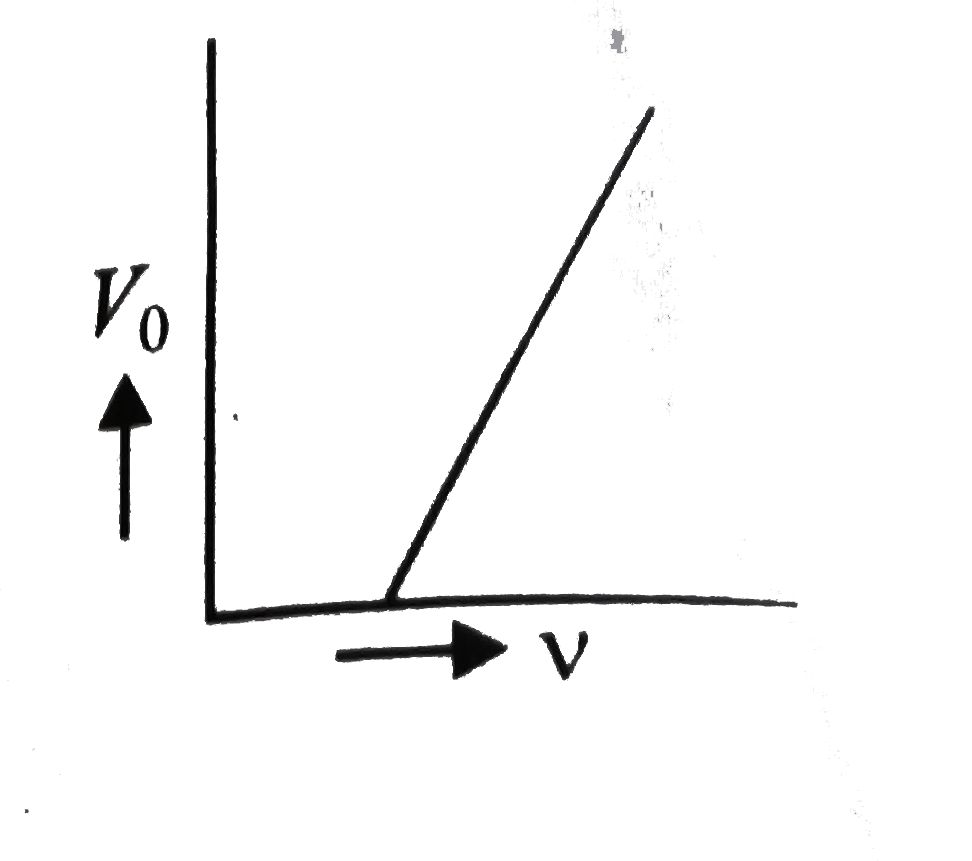The work function of cesium is 2.14 eV. Find (a) the threshold frequency for cesium, and (b) the wavelength of the incident light if the photo current is brought to zero by a stopping potential 0.60 V. Given h=6.63×10−34Js.
To solve the problem step by step, we will break it down into two parts as requested.
Part (a): Finding the Threshold Frequency for Cesium
1. Identify the Work Function:
The work function (W) of cesium is given as 2.14 eV. We need to convert this into joules.
W=2.14eV×1.6×10−19J/eV=3.424×10−19J
2. Use the Formula for Threshold Frequency:
The threshold frequency (ν0) can be calculated using the formula:
W=hν0
Rearranging gives:
ν0=Wh
3. Substitute the Values:
We know Planck's constant h=6.63×10−34Js. Now substitute the values:
ν0=3.424×10−19J6.63×10−34Js≈5.16×1014Hz
4. Final Result for Part (a):
ν0≈5.16×1014Hz
Part (b): Finding the Wavelength of the Incident Light
1. Identify the Stopping Potential:
The stopping potential (V0) is given as 0.60 V. The energy corresponding to this potential is:
E=eV0=1.6×10−19C×0.60V=9.6×10−20J
2. Use the Energy Equation:
The total energy of the incident light can be expressed as:
E=hν−W
Rearranging gives:
hν=E+W
3. Substituting for Frequency:
We can express the frequency ν in terms of wavelength λ:
ν=cλ
where c=3×108m/s. Thus,
hcλ=E+W
4. Rearranging for Wavelength:
Rearranging gives:
λ=hcE+W
5. Substituting the Values:
Now substitute h, c, E, and W:
λ=(6.63×10−34Js)(3×108m/s)(9.6×10−20J+3.424×10−19J)
6. Calculating the Denominator:
E+W=9.6×10−20+3.424×10−19=4.384×10−19J
7. Final Calculation for Wavelength:
λ=(6.63×10−34)(3×108)4.384×10−19≈4.54×10−7m=454nm
Final Results:
- (a) Threshold frequency ν0≈5.16×1014Hz
- (b) Wavelength of the incident light λ≈4.54×10−7m or 454nm
The work function (W) of cesium is given as 2.14 eV. We need to convert this into joules.
W=2.14eV×1.6×10−19J/eV=3.424×10−19J
The threshold frequency (ν0) can be calculated using the formula:
W=hν0
Rearranging gives:
ν0=Wh
We know Planck's constant h=6.63×10−34Js. Now substitute the values:
ν0=3.424×10−19J6.63×10−34Js≈5.16×1014Hz
ν0≈5.16×1014Hz
The stopping potential (V0) is given as 0.60 V. The energy corresponding to this potential is:
E=eV0=1.6×10−19C×0.60V=9.6×10−20J
The total energy of the incident light can be expressed as:
E=hν−W
Rearranging gives:
hν=E+W
We can express the frequency ν in terms of wavelength λ:
ν=cλ
where c=3×108m/s. Thus,
hcλ=E+W
Rearranging gives:
λ=hcE+W
Now substitute h, c, E, and W:
λ=(6.63×10−34Js)(3×108m/s)(9.6×10−20J+3.424×10−19J)
E+W=9.6×10−20+3.424×10−19=4.384×10−19J
λ=(6.63×10−34)(3×108)4.384×10−19≈4.54×10−7m=454nm
- (a) Threshold frequency ν0≈5.16×1014Hz
- (b) Wavelength of the incident light λ≈4.54×10−7m or 454nm
Topper's Solved these Questions
Similar Questions
The work function of Cs is 2.14eV.Find
(a) threshold frequency for Cs
(b) Wavelength of incident light if the photo current is brought to zero by stopping potential of 0.6 V.
View SolutionThe work function of a photoelectric material is 4.0 e V. (a) What is the threshold wavelength? (b) find the wavelength of light for which the stopping potential is 2.5 V.
View Solution
Knowledge Check
The work function of Cs is 2.14 ev find the wavelength of the incident light if the stopping potential is 0.6 V.
A326 nmB454 nmC524 nmD232 nmWhen light of wavelength 400nm is incident on the cathode of photocell, the stopping potential recorded is 6V. If the wavelength of the incident light is to 600nm, calculate the new stopping potential. [Given h=6.6×10−34Js,c=3×108m/s,e=1.6×10−19C]
A1.03VB2.42VC4.97VD3.58V
The work function of a metal is 2.5×10−19J. (a) Find the threshold frequency for photoelectric emission. (b) If the metal is exposed to a light beam of frequency 6.0×1014 Hz, what will be the stopping potential ?
View SolutionThe work function of a metal is 3.0 V. It is illuminated by a light of wave length 3×10−7m. Calculate i) threshold frequency, ii) the maximum energy of photoelectrons, iii) the stopping potential.
(h=6.63×10−34Jsandc=3×108ms−).
View SolutionThe work function of a surface of a photosensitive material is 6.2eV. The wavelength of the incident radiation for which the stopping potential is 5V lies in the
View SolutionWork function of a metal is 3.0 eV. It is illuminated by a light of wavelength 3×10−7 m. Calculate the maximum energy of the electron.
View SolutionThe threshold frequency of a material is 2×1014 Hz. What is its work function in eV ?
View SolutionThe emission of electrons from a metal surface exposed rto light radaition of appropriate wavelength is called photoelectric effect .The emmited electron are called photo=-weklectron work function of threshold energy may be defined as the minimum amount of energy required to ejected electron from a most surface .According to Einstein
Maximum kinetic energy of ejected electron = Absorbed energy - Work function
12mv2max=h(v)−h(vn)=hv[1λ−1λn]
Where vn and λ0 are thereshold frequency and threshold wavelength respectively
Sopping potential : it is the miximum potential at which the photoelectric current becomes zero if V0 is the stopping potential eV0=h(v−v0)
In the photoelectric currect effect the shape of strainght line graph between stopping potential (V0) and frequency of incident light (V) gves

View Solution
